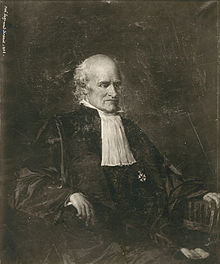Raphaël Bienvenu Sabatier
Raphaël Bienvenu Sabatier (born October 11, 1732 in Paris , † July 19, 1811 there ) was a French surgeon.
Life
The son of the surgeon Pierre Sabatier had developed a curious urge to explore the world at an early age. At the age of thirteen he decided to learn the learned languages of that time. In 1745 he had drafted a treatise on the convalescence of Louis XV , with which he won a prize at the College des Quatre Nations . At the same time he had further developed his education in the philosophical sciences of physics, geometry, music and drawing. In his hometown, he was able to acquire the academic degree of a master's degree in philosophy at the age of seventeen and then take up a degree in surgery.
He had followed the statements by Jean-Louis Petit and César Verdier , had become a student at the Hôpital de la Charité and made sure that the monks in Paris could no longer perform operations. After he had received his doctorate in medicine on May 20, 1752 with the dissertation "de bronchotomia", he was appointed a member of the Academy of Surgery at the age of twenty. As such, he gave lectures on the anatomy of living animals some time later. In 1757 he was succeeded Balleul professor of anatomy at the royal college of surgeons of Saint Côme (French Confrérie de Saint-Côme et de Saint-Damien ).
After meeting Jean François Clément Morand , he was adjunct in 1759 and chief surgeon at the Hôtel des Invalides in 1773 . In the same year he became a member of the Académie des sciences and gave lectures on anatomy. Already during the revolution he had taken over the inspection of the hospitals of the army and in 1804 was appointed one of Napoleon's surgeons ( chirurgien consultant de l'Empereur ). He was awarded the Legion of Honor for his services. Since it was founded in 1795, Sabatier has been a member of the Institut de France .
Act
Sabatier was a famous surgeon in his day who made an important contribution to the development of urology and its recognition as a separate medical discipline. He also left behind a considerable number of treatises, including those for the Académie des sciences. In these he treated the unequal capacity of the heart and the pulmonary vessels, the circulation in the fetus, the location of the heart, the lungs and the great vessels, the structure of the brain and its sheaths, the movements of the thorax and the action of the intercostal muscles, via rabies , Transverse fracture of the collarbone and so on. In the Memoires de l'Acad. royal de chirurgie he wrote about a case of ectopic pregnancy , gastric hernia , changes in the position of the uterus and vagina, fracture of the femoral neck , unnatural anus and many other subjects.
The Memoires de l'Institut contain valuable articles by Sabatier on the use of opium in large doses for tetanus traumaticus, on fractures of the sternum, on stone incisions with the lithotome caché by Jacques Baulot (1651–1719), on changes in the circulation in the fetus, about resection of the humerus head, etc. His main work is a manual of anatomy, which appeared under the title De la médecine opératoire in 1796 in three volumes and experienced several editions. Sabatier, like his contemporary Pierre-Joseph Desault, were the heads of rival French schools of surgeons. Sabatier, relying on his famous predecessors Petit , Antoine Louis and Morand , tried to develop their teachings and was not very open to innovations. While Desault was tearing down the old building piece by piece, striving to rebuild it on a new foundation, creating a multitude of adversaries.
Works
- Traité d 'anatomie. Paris 1764, 3rd vol.
- Mémoire sur les nerfs de la dixième paire . 1776.
- Mémoire sur quelques particularitiés de la structure du cerveau et de ses enveloppes. 1776.
- De la médecine opératoire, ou des opérations de Chirurgie qui se pratiquent le plus fréquemment. 2nd Edition. Paris, Didot le Jeune, 1796, 3rd vol., 1822–1824, 4th vol., In German 1797–1799 3rd vol., 3rd edition. 4th vol., Paris 1822-1824.
- Traité complet d'anatomie, ou, Description de toutes les parties du corps humain. Théophile Barrois le Jeune, 1798.
literature
- Otto Wigand: Conversations Lexicon. For all stands. Volume 12, Leipzig 1851, p. 177. (online)
- August Hirsch : Biographical lexicon of the outstanding doctors of all times and peoples. (BÄL) Urban & Schwarzenberg, Vienna / Leipzig 1887, p. 136.
- Barbara I. Tshisuaka: Sabatier, Raphael Bienvenu. In: Werner E. Gerabek : Encyclopedia Medical History. Walter de Gruyter, Berlin 2004, ISBN 3-11-015714-4 , p. 1279.
- Gottingen scholarly advertisements, under the supervision of the royal. Society of Sciences. Volume 3, Heinrich Dietrichs, Göttingen 1812, p. 1571 f. (on-line)
- Johann Nepomuck Rust: Theoretical-practical manual of surgery, including syphilitic and eye diseases. Volume 14, Enslin-Gerold, Vienna / Berlin 1834, p. 387, (online)
- Victor d'Azyr: Encyclopédie méthodique. Volume 12, Verlag Agasse, Paris 1827, p. 638. ( online , French)
- Biography universal (Michaud) ancienne et modern. Volume 37, C. Desplaces / FA Brockhaus, Paris / Leipzig 1857, p. 171. ( online , French)
- Joseph Marie Quérard: La France littéraire: ou Dictionnaire bibliographique. Freres, Paris 1836, p. 290. ( online , French)
- Louis Mayeul Chaudon: Dictionnaire universel, historique, critique et bibliographique. Paris 1811, p. 369. ( online , French)
- Antoine Jacques Louis Jourdan: Dictionaire des sciences médicales: Biography médicale. Volume 7, Panckoucke, Paris 1825, p. 80. ( online , French)
Web links
| personal data | |
|---|---|
| SURNAME | Sabatier, Raphaël Bienvenu |
| BRIEF DESCRIPTION | French medic |
| DATE OF BIRTH | October 11, 1732 |
| PLACE OF BIRTH | Paris |
| DATE OF DEATH | July 19, 1811 |
| Place of death | Paris |
